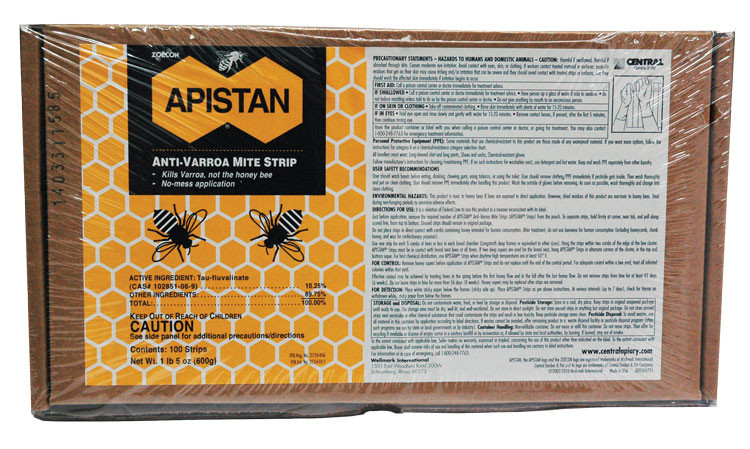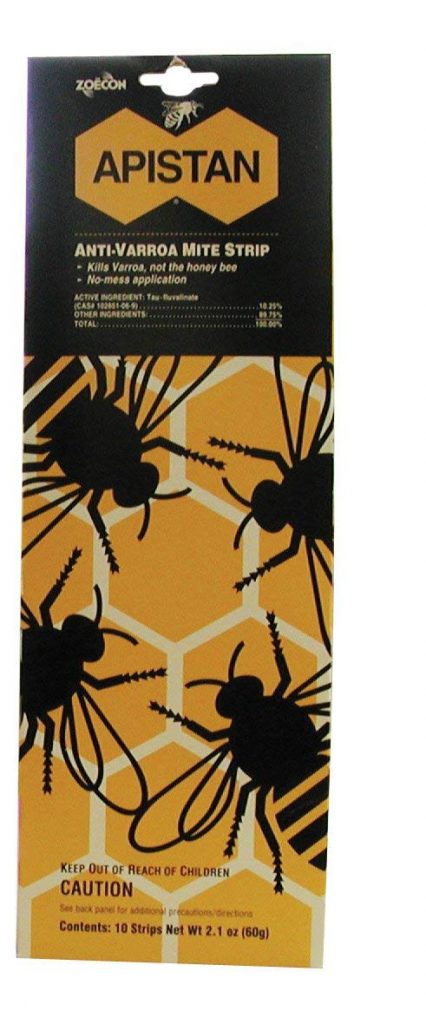If you purchase an independently reviewed item through our site, we earn an affiliate commission. Read our affiliate disclosure.
Review Overview
Our Rating
The Mann Lake DC665 Apistan Strips are a Varroa mite control option that, while effective in the short term, may present long-term challenges. They are easy to apply and have a high initial efficacy, but their active ingredient, Tau-Fluvalinate, can lead to mite resistance and leave harmful residues in beeswax. These strips are best used in early spring or late fall and are not recommended during honey flow. They require careful handling and disposal after 6-8 weeks of use. While they can be a quick fix in emergency situations, beekeepers are advised to vary mite treatments to prevent resistance and safeguard bee health.
Apistan is used in the detection and control of Varroa mites. Mann Lake recommends the use of their Apistan early in spring or late fall. The Mann Lake DC665 Apistan strips should not be used during honey flow. An application rate of 1 strip for every 5 beehive frames is recommended. The 10-strip pack is suitable for beekeepers with a beehive or two only. For large apiaries, the 100-strip pack is more appropriate. However, right off the bat, we’ll say that while the Apistan strips can be effective in mite control, their side effects and lessening effectiveness over time make it hard to recommend compared to other mite control methods.
About the Mann Lake DC665 Apistan Strips
Mann Lake uses a slow-release polymer formulation in these Apistan strips. The active ingredient in Apistan is Tau-Fluvalinate. It is a synthetically prepared fat-soluble pyrethroid. As mentioned, using Apistan in your beehives comes with a certain risk. Mites have been noted to develop resistance to it when used continuously over time. It can also remain a residue in beeswax. If the levels of Apistan in the wax reach lethal levels for bees, beekeepers are faced with a colony collapse. Additionally, Apistans stand accused of contributing to the proliferation of the Deformed Wing Virus in honey bee colonies. Exposing your bees to Apistan can cause the queen bee to weigh less, and drones to die earlier than is normally seen.
Using the Mann Lake DC665 Apistan Strips
The Mann Lake DC665 Apistan strips must be used at the recommended rate of 2 strips for every 10 beehive frames. Beehives with many stacked boxes require a high number of strips used. Place the strips in high-traffic areas of your beehive boxes. It is also important to spread out your strips throughout the beehive. Do not place all strips in one place. Strips may be hung between frames, stuck to the sides of beehives, and placed near entrances.
The Apistan strips work by releasing a small amount of the active ingredient to bees coming into contact with the strips. Bees gradually spread the Apistan throughout the beehive. As mites die, any eggs they may have laid hatch and the offspring dies too. In 6 weeks, your beehive should be clear of mites and their eggs as well. After 6-8 weeks of use in your beehive, be sure to remove the strips and dispose of them well.
Dead mites fall off the back of bees after treatment with the Apistan strips. Beekeepers may sweep these from the hive themselves if they use solid bottom boards. For those with screened bottom boards in their hives, the mites fall to the ground under the hive. Solid bottom boards allow you to easily see the efficacy of Apistan strips.
Pros and Cons
Pros
- The strips has a high proven efficacy. In the recommended six weeks of treatment, your beehive is cleared of mites and their eggs.
- The strips are easy to apply. They attach well to selected beehive locations and stay on.
Cons
- Leaves residue in beeswax, which if accumulated enough, can become lethal to bees.
- Over-application of the strips leads to mites developing resistance. This requires beekeepers to cycle between mite control methods. Apistans are not effective after a few seasons where resistance had developed.
- Apistans can wreak havoc on honey bee colonies when overused. Despite their low toxicity to bees, they may affect both the peripheral and central nervous systems of honey bees.
A Word of Caution
- You may not use the Apistan strips with honey supers. If honey super boxes are present in your beehive boxes stack, remove them. This is the reason beekeepers using Apistan strips to control mites do it in early summer or late fall. Apistan strips are not reusable once their 6-8 week period of use is over.
- Beekeepers should wear gloves when working with the Mann Lake DC665 Apistan strips since they contain a chemical that can be harmful if swallowed.
- Do not drink, eat or smoke during the application of Apistan strips.
- Your beehive may not use up all the Apistan strips in the pack. If this happens, keep the unused strips in their pouch and store them in a cool dry place, away from foodstuffs. You should also keep them separated from other chemicals that may contaminate the strips.
Testing for Apistan Resistance in Honey Bee Mites
Resistance to pyrethroids is a concern for beekeepers using the Mann Lake DC665 Apistan strips for mite control. To check for resistance, first, establish a healthy mite population in your beehive on bees. Next, place an Apistan strip in the colony and check for mite drop rate over the next 24 hours. If there is resistance, you will note a low mite drop rate. If there is no resistance, the mite drop rate will be in the hundreds.
A second more rigorous test for resistance involves placing adult bees in a test container and assessing mite mortality after 3 hours. The bees you put in the container should have mites on them, and an Apistan strip is placed in the container. To avoid mites developing resistance to Apistans, beekeepers are advised to vary treatment types seasonally. Resistance to pyrethroids in mites drops by significant levels when pyrethroid treatment is terminated.
Conclusion
The Mann Lake DC665 Apistan Strips do work and are effective in getting rid of Varroa mites, but their side effects far outweigh their benefits. However, if you’re having a dire emergency, the Apistan strips are available for purchase both online and from beekeeping supplies retailers near you.
Have you used the Mann Lake DC665 Apistan Strips in your beehives? Leave a comment below and let us know what you think of it.
 BeeKeepClub Resources and Guides for Beekeepers
BeeKeepClub Resources and Guides for Beekeepers


